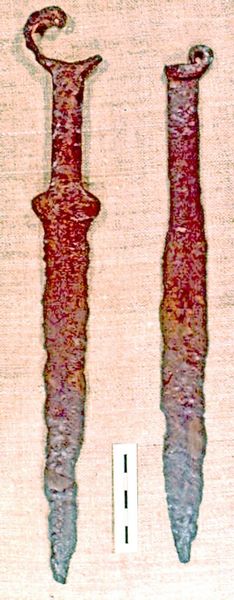Blacksmithing of the Kerkets and Tоrets
Iron Products in the production Culture of the Population of the Abrau Peninsula

Archaeological evidence suggests that the products of black metal occupied a significant place in the life of the local population since the beginning of the iron age. First of all it refers to the weapons – numerous findings of daggers, swords, spearends, axes, arrows. The study of manufacturing technology of forging products using metallographic methods allows identifying typical local features of ironprocessing and foreign cultural impact.
Technological analysis of forging artifacts since archaic-classic time spreading from the territory inhabited by of the Sinds, Kerkets and Torets showed that already at an early stage (7th–5th centuries BC) in the manufacture of products two traditions are clear: one based on highly advanced technologies, the other on simple technologies. For the early iron age the criterion of high technologies was targeted at (artificial) obtaining high-quality high-carbon steel and its heat treatment. This steel was obtained also by carburizing (cementation) of iron. This is a very time-consuming process, it required more than nine hours of keeping of an object a work piece in a particular environment at a certain temperature to get the steel layer of 3–4 mm thick. Finding the ways to increase the mechanical properties of steel products by heat treatment (quenching) is another great achievement in the production of black metal. The use of such advanced technology for that time (7/4th centuries BC), was known only in a few industrial centers, for example, in the area of Kolhida-Koban culture. Identifying the blacksmith handmade goods in local sites, the products made with such technologies, suggests that they were imported and had came there from centers with established traditions of obtaining cemented steel and its heat treatment. In this sense the materials of the monuments located on the territory of Syndic (burial grounds at Khutor Rassvet, Fadeevo, Krasniy mound, from the villages of Gajkodzor and Pervomayka, Gostagaevskaya Stanitsa) are of particular interest. According to metallographic research most products early stage of the local culture demonstrates develloped forging technique. As it was found out, they were made of specially obtained steel. They used various methods of carburizing. In addition, almost all the products were subjected to heat treatment – soft hardening. Such products may have come from the production centers located on the territory occupied by the tribes of the Koban culture, where the use of cemented steel and its methods of its heat treatment had been known in Skythian period before. The geographical position of Syndic apparently made it open to broad cultural contacts.
Another picture show the materials of the synchronous period on the territory where the Kerkets-Torets had lived (burial 1 in Tsemdolina Tsemess valley and a burial ground near of Rayevskaya Hillfort). According to the data of metallographic research of forged products, in the manufacture of products there they used simples technologies: the most of craft had been forged entirely of iron or raw steel, obtained unintentionally during the metallurgical process. In some cases, a packaged billet made of strips of iron and raw steel had been used. These materials most clearly reflect the characteristic features of local metal processing, remaining for many centuries, in spite of various foreign cultural influences. Only with a new wave of Bosporus colonization in 1th–3th centuries AD, and apparently in connection with the incorporation in the local environment of the Bosporus masters, begins a new stage in the development of metal production based on broad use of cemented steel, heat treatment, welding technology.
(Natalia N.Terekhova)
